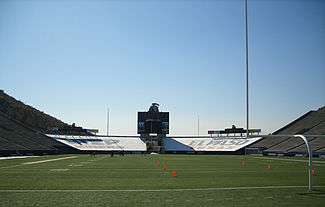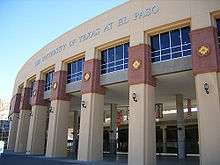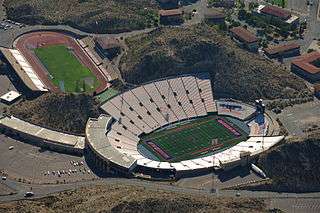Sun Bowl (stadium)
|
Sun Bowl stadium in the foreground; Kidd Field is in the background | |
| Location |
Sun Bowl Drive El Paso, TX 79968 |
|---|---|
| Coordinates | 31°46′24″N 106°30′29″W / 31.77333°N 106.50806°WCoordinates: 31°46′24″N 106°30′29″W / 31.77333°N 106.50806°W |
| Owner | University of Texas El Paso |
| Operator | University of Texas El Paso |
| Capacity |
51,500 (2001–present)[1] 52,000 (1982–2000) 30,000 (1963–1981) |
| Surface |
FieldTurf 2015 to present AstroPlay 2001 to 2014 AstroTurf 1974 to 2000 grass 1963 to 1973 |
| Construction | |
| Broke ground | August 1, 1961[2] |
| Opened | September 21, 1963 |
| Renovated | 2006 |
| Expanded | 1982 |
| Construction cost | $275,000 (approximate, original) |
| Architect |
Garland & Hilles Carroll & Daeuble |
| General contractor | Ponsford Brothers |
| Tenants | |
|
UTEP Miners (NCAA) (1963–present) Hyundai Sun Bowl Game (NCAA) (1963–present) El Paso Patriots (USL PDL) (1989–2001) Texas vs. The Nation Game (NCAA) (2007–2010) El Paso ISD (selected games) | |
The Sun Bowl is an outdoor football stadium, on the campus of the University of Texas at El Paso. It is home to the UTEP Miners of Conference USA, and the late December college football bowl game, the Hyundai Sun Bowl. The stadium was opened in 1963 and has a current seating capacity of 51,500.
The land on which the stadium sits was originally donated by the university to El Paso County, Texas, who built the stadium for the school and the Sun Bowl game. Both had previously used Kidd Field, the school's current track and field stadium, which only seats 15,000. The city had realized that the game could not expand its audience or the list of teams that it could invite without a bigger stadium, so the Sun Bowl was built in a natural bowl lying to the west of the old stadium. The AstroPlay playing field runs nearly north–south (tilted about 10° NW-SE) and is at an elevation of 3910 feet (1191 m) above sea level.
The stadium, named for the game it hosts, was opened in September 1963 with a Texas Western win over North Texas State. The opening play was a 54-yard touchdown run by Larry Durham of the Miners.
It originally sat 30,000, with only the sideline grandstands. The current press box was added in 1969, and the stadium reached the capacity of 52,000 in 1982 with the addition of the north end zone stands and the expansion of the east stands (The south end zone is still vacant, with the ground of the bowl covered with the school's logos.) The school retook control of the land and stadium in 2001. Also in 2001, hundreds of seats were removed as part of a re-configuration of the seating bowl in order for soccer to be played at the stadium, which lowered capacity to its current figure of 51,500.[1]
For a short time before moving to Dudley Field, it was the home to PDL franchise, the El Paso Patriots. They now play at Patriot Stadium.
On February 2, 2007, the stadium hosted the first ever Texas vs. The Nation all star college football game. The Nation team defeated the Texas team by a score of 24–20.
The Sun Bowl is also a venue for music and other large public events, having hosted concerts by U2, The Rolling Stones, Pink Floyd, and Kenny Chesney. Recently on September 19, 2014, the stadium hosted the English-Irish boy band One Direction as part of their Where We Are tour with 5 Seconds of Summer as the opening act and sold out, a record for the Sun Bowl. The concert saw close to 60,000 people from numerous countries. On February 17, 2016, the stadium hosted festivities and a simulcast of the Mass held by Pope Francis during the pontiff's visit to Ciudad Juarez, Mexico, several miles away across the Rio Grande.
Photos
 Sun Bowl stadium view from Durham Center
Sun Bowl stadium view from Durham Center Sun Bowl stadium view from tunnel
Sun Bowl stadium view from tunnel View from within Sun Bowl stadium
View from within Sun Bowl stadium
 Sun Bowl stadium view from northern entrance
Sun Bowl stadium view from northern entrance
References
- 1 2 "UTEP-Marshall Game Sold Out". UTEP Athletics. Retrieved October 9, 2012.
- ↑ "Bean Tags Charge As "Ridiculous"". The Bonham Daily Favorite. September 6, 1962. Retrieved September 27, 2011.
External links
| Wikimedia Commons has media related to Sun Bowl Stadium. |
- UTEP Athletics – Sun Bowl Stadium
- Aerial photo (& topographic map) of UTEP campus from USGS The National Map
| Events and tenants | ||
|---|---|---|
| Preceded by Kidd Field |
Home of the Sun Bowl 1963–present |
Succeeded by Current |
| Preceded by Kidd Field |
Home of the UTEP Miners 1963–present |
Succeeded by Current |
